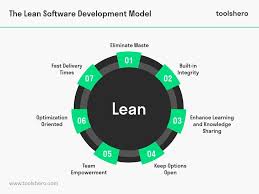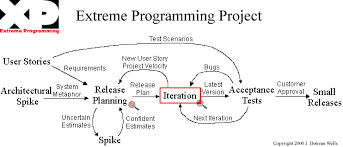Agile and Lean Software Development
Agile and Lean software development are two popular methodologies used in the software industry to improve efficiency, productivity, and overall project success. While they share some similarities, they also have distinct differences that set them apart.
Agile Software Development:
Agile software development is a flexible and iterative approach that focuses on delivering small increments of working software throughout the development process. This methodology emphasizes collaboration, adaptability, and customer feedback. Agile teams work in short iterations known as sprints, where they plan, develop, test, and deliver working software in a continuous cycle.
Key principles of Agile include responding to change over following a plan, customer collaboration over contract negotiation, working software over comprehensive documentation, and individuals and interactions over processes and tools.
Lean Software Development:
Lean software development is based on the principles of lean manufacturing and aims to eliminate waste, increase efficiency, and deliver value to customers. This methodology focuses on creating a smooth flow of work by identifying and eliminating bottlenecks in the development process.
Key principles of Lean include eliminating waste (such as unnecessary features or processes), amplifying learning through fast feedback loops, empowering the team to make decisions at the lowest level possible, delivering as fast as possible while maintaining high quality standards.
Conclusion:
Both Agile and Lean software development methodologies offer valuable approaches to improving the efficiency and effectiveness of software projects. While Agile focuses on adaptability and customer collaboration through iterative cycles, Lean emphasizes eliminating waste and maximizing value delivery. By understanding the principles of both methodologies, teams can tailor their approach to best suit their project requirements for successful outcomes.
8 Essential Tips for Mastering Agile and Lean Software Development
- 1. Embrace change and welcome it as a way to improve the product.
- 2. Prioritize collaboration and communication among team members.
- 3. Deliver working software frequently, in short iterations.
- 4. Focus on customer satisfaction by delivering value early and often.
- 5. Encourage self-organizing teams to make decisions collectively.
- 6. Continuously reflect on ways to improve processes and efficiency.
- 7. Eliminate waste by identifying and removing unnecessary tasks or activities.
- 8. Use feedback loops to gather insights for continuous improvement.
1. Embrace change and welcome it as a way to improve the product.
Embracing change and welcoming it as a means to enhance the product is a fundamental principle in both Agile and Lean software development methodologies. By remaining open to adapting and evolving throughout the development process, teams can respond effectively to new insights, feedback, and market demands. This proactive approach not only fosters innovation but also ensures that the final product meets or exceeds customer expectations by incorporating valuable improvements along the way.
2. Prioritize collaboration and communication among team members.
Prioritizing collaboration and communication among team members is a crucial tip in both Agile and Lean software development methodologies. By fostering open communication channels and encouraging teamwork, team members can share ideas, provide feedback, and work together towards a common goal. Effective collaboration ensures that everyone is aligned on project objectives, minimizes misunderstandings, and promotes a culture of transparency and trust within the team. Ultimately, prioritizing collaboration and communication leads to improved productivity, better decision-making, and successful project outcomes in the fast-paced world of software development.
3. Deliver working software frequently, in short iterations.
To achieve success in agile and lean software development, it is crucial to adhere to the principle of delivering working software frequently in short iterations. By breaking down the development process into manageable chunks and consistently providing functional software, teams can gather valuable feedback from stakeholders early on, make necessary adjustments promptly, and ensure that the final product meets user requirements effectively. This iterative approach not only promotes collaboration and transparency within the team but also allows for continuous improvement throughout the project lifecycle, ultimately leading to higher customer satisfaction and successful project outcomes.
4. Focus on customer satisfaction by delivering value early and often.
In Agile and Lean software development, a key tip is to focus on customer satisfaction by delivering value early and often. By prioritizing the needs and feedback of the customer, teams can ensure that they are building software that aligns with user expectations and requirements. This approach allows for continuous validation of the product throughout the development process, leading to higher customer satisfaction and ultimately a more successful end product.
5. Encourage self-organizing teams to make decisions collectively.
Encouraging self-organizing teams to make decisions collectively is a key tip in Agile and Lean software development methodologies. By empowering team members to collaborate and take ownership of decision-making processes, organizations can foster a culture of innovation, creativity, and accountability. This approach not only promotes a sense of shared responsibility within the team but also leads to more efficient problem-solving and faster delivery of high-quality software products. Ultimately, allowing self-organizing teams to make decisions collectively can result in increased productivity, improved team morale, and better overall project outcomes.
6. Continuously reflect on ways to improve processes and efficiency.
Continuously reflecting on ways to improve processes and efficiency is a crucial tip in Agile and Lean software development. By regularly evaluating current practices, teams can identify areas for enhancement and implement changes to streamline workflows and optimize productivity. This iterative approach fosters a culture of continuous improvement, where teams are empowered to adapt and evolve their processes to deliver higher quality software more effectively. Embracing this mindset of reflection and refinement is key to achieving success in Agile and Lean software development methodologies.
7. Eliminate waste by identifying and removing unnecessary tasks or activities.
To enhance efficiency and productivity in software development, a crucial tip from both Agile and Lean methodologies is to eliminate waste by identifying and removing unnecessary tasks or activities. By streamlining the development process and focusing on essential tasks, teams can optimize their workflow, reduce time wastage, and deliver value to customers more effectively. This practice aligns with the core principles of Lean software development, emphasizing the importance of delivering quality results efficiently by cutting out any non-value-adding elements in the project lifecycle.
8. Use feedback loops to gather insights for continuous improvement.
Utilizing feedback loops is a crucial tip in Agile and Lean software development processes. By gathering insights from stakeholders, team members, and end users through feedback loops, teams can continuously improve their products and processes. This iterative approach allows for adjustments to be made promptly based on real-time feedback, leading to enhanced product quality, increased customer satisfaction, and overall project success. Implementing feedback loops fosters a culture of continuous improvement within the team, driving innovation and efficiency in software development projects.




